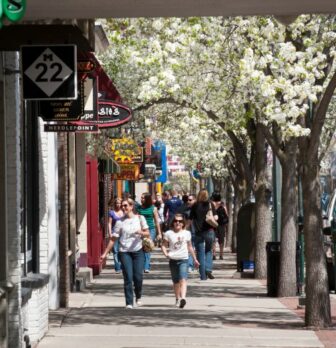In our 2006 A New Agenda for a New Michigan we wrote: “For many Michiganians, vibrant central cities are part of the past. No longer relevant or just something you visit in unique places like Manhattan, Toronto or Chicago. Think again! They are an important ingredient to future economic success. The pattern across the country is clear: high prosperity metropolitan areas have central cities with a concentration of knowledge workers. Michigan employers who are recruiting young talent from across the country understand this. Those we talked with for this project told us that the absence of a vibrant central city impedes their ability to attract talent.”
Today its even clearer that central cities are a major engine of economic growth. Unfortunately that reality is not reflected in Michigan’s policy priorities. Its another major area where we are pursuing 20th Century policy in a world that has changed fundamentally. As former State Treasurer Robert Kleine demonstrated in a terrific Detroit Free Press op ed the state has not made central cities a priority since Governor Milliken four decades ago. Big mistake.
Knowledge-based private sector employers increasingly get it. Think Quicken Loans here. The New York Times recently featured Amazon’s new headquarters in a formerly not great Seattle neighborhood. The Times writes:
The setting is significant. In casting its lot in the center of a congested, bustling city, Amazon has rejected the old model of the suburban company campus that is typical of Silicon Valley and the technology ring road around Boston. The old way is perhaps most vividly exemplified by Microsoft. Its offices, and most of its 42,000 local employees, are about 18 miles from downtown Seattle, in the suburb of Redmond. …
Other technology companies are moving into urban spaces. Twitter and Dropbox, the social networking and online storage services, have made San Francisco home, while Tumblr and Etsy, blogging and shopping sites, are in New York. Google has huge urban spaces from Paris to Pittsburgh. The appeal of cities to potential employees is part of the reason for the shift. An urban setting, with access to good restaurants, nightclubs and cultural attractions, has become as important a recruiting tool as salary or benefits for many companies. (Emphasis added.)
… Mr. Schoettler, Amazon’s real estate director, said environmental considerations were an important factor in the company’s decision to remain in Seattle, along with the type of employee that an urban location attracts. “The energy and excitement from employees being in an urban environment — I hear it daily,” said Mr. Schoettler, who walks to work. “A lot of people don’t even have a car. They want that urban experience right there.”
In a talent driven economy –– where talent increasingly wants to live and work in a vibrant, walkable central city neighborhood –– companies are moving to where the talent is. And its not just established companies like Amazon and Quicken its also venture capital backed start ups. In a terrific series on where venture capital is investing Richard Florida for Atlantic Cities is documenting this move of technology start ups from what he calls suburban nerdistans to central cities.
In an overview article for the series entitled The Connection Between Venture Capital and Diverse, Dense Communities Florida writes: “When all is said and done, venture capital and start-up activity today is associated with denser, more talent-driven, more diverse and innovative metros, reflecting the increasingly spiky nature of America’s economic landscape.” Be sure to check out his articles on San Fransisco –– which now is garnering more venture fund investment than Silicon Valley (amazing!) and the big east coast metros (New York, Boston, and believe it or not Washington DC) where the central city is becoming the big player in venture capital investments. You read that right DC is no longer just a government town (even more amazing).
As Florida writes: Long gone are the days when high-tech startups were overwhelmingly located in sprawling suburban nerdistans. The center of gravity for venture capital and startup activity in the Bay Area today appears to have shifted to central cities. “For all its power, Silicon Valley has a great weakness,” wrote legendary Silicon Valley investor Paul Graham, its “soul-crushing suburban sprawl.” But, he added, “a competitor that managed to avoid sprawl would have real leverage.” That “competitor” has turned out to be nearby San Francisco. … This is of course in line with what urban theory has long held: That it is dense, diverse and dynamic cities filed with flexible and reconfigurable old buildings that are the real font of innovation.
Whether its established companies like Amazon or technology based start ups this is the kind of investment that is central to every state’s economic development strategy. These are the investments everyone wants. Turns out to get them you need central cities that are attractive places for mobile talent to live and work. Not exactly the current Michigan economic policy priority. The sooner we learn this new reality the better off we will be.






